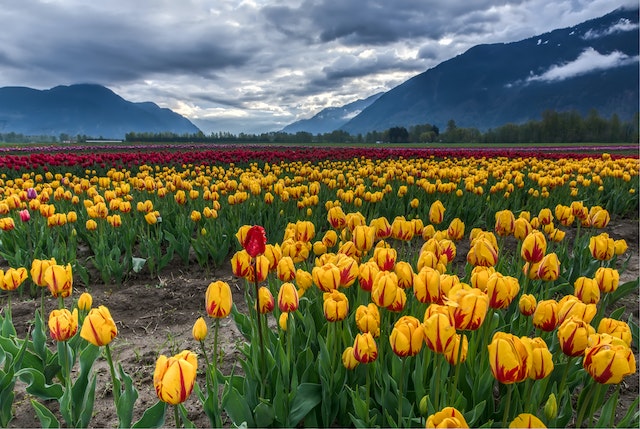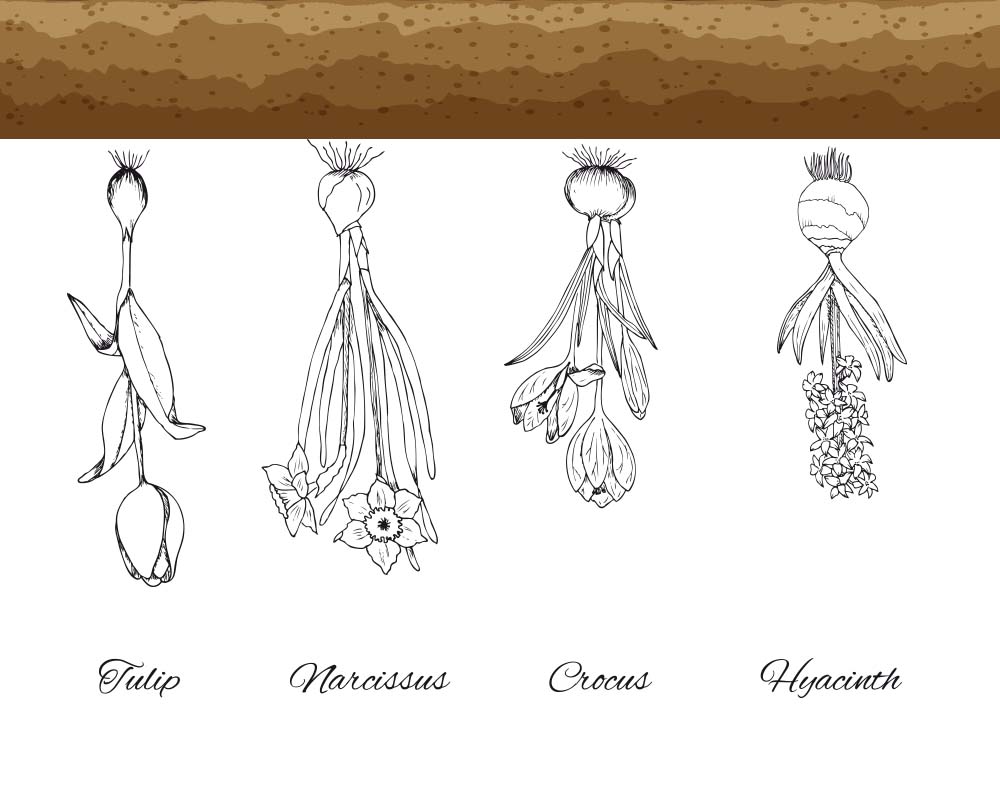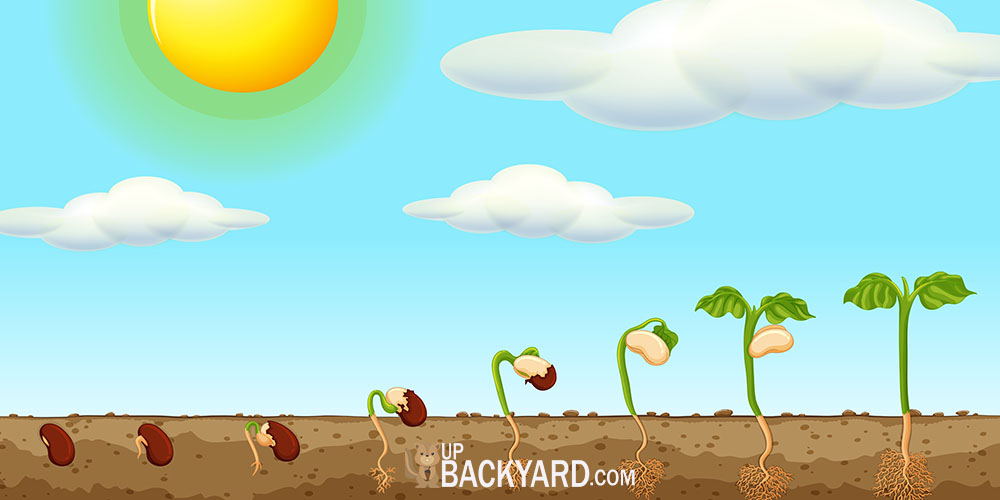Tulips, hyacinths, daffodils, lilies, and Dutch irises are just a few of the beautiful plants you can grow in your garden from bulbs.
Bulbs are a type of organ that allows for the plant to survive dormancy. You can think of bulbs like a large seed.
Seeds contain living tissue and the ability to grow into plants. Bulbs can be dug up and used again or even left in place over a long winter to sprout again in the spring.
If you are planting bulbs for the first time, it is important to know which side is up and which side is down. The pointed end should face upwards and the wider end should be facing downwards.
The plant will grow out of the pointed end, so being sure that it is facing upwards is important for the plant’s growth. But…
What Happens If The Bulb Is Planted Upside Down?
Like seeds, bulbs begin to grow in complete darkness. They have enough energy stored within themselves to produce a seedling and sprout roots to sustain itself until the seedling can grow leaves and begin using photosynthesis.
Bulbs know which way is up, so regardless of which way you plant them, they will find their way upwards and outwards into the world.
While they will still grow, planting them upside down can create stress on the bulb and use up more of the limited stored energy.
When Do I Plant Bulbs?
The best time to plant bulbs depends on the type of bulb it is and when the plant will grow.
Some bulbs are best planted in the fall while others are best planted in the spring after all chance of frost has passed.

Spring blooming bulbs like daffodils and tulips should be planted in the fall. September – October is the best time to drop these bulbs into the ground.
The moist soil and cooler temperatures help the bulbs settle in before the long winter. Once spring arrives, these bulbs will burst forward filling your garden with beautiful colors and scents.
Flowers that bloom in the summer should be planted in the spring when all chances of frost have passed. It is common to plant these a little after the first spring bulbs begin to come up.
Spring flowers from bulbs have a greater resistance to cold and can even survive light frosts that often come with early spring.
Do I Need To Dig Up My Bulbs?
After the bulbs have bloomed and faded, it is common to wonder if you need to dig them up and store them for the following year.
It depends entirely on the type of flower bulb it is.
Early spring blooming bulbs that would otherwise be planted in September or October are okay to leave in the ground. They are hardy and can survive the freezing cold of winters.
You can dig them up if you notice that they are not producing as well as in previous years. If they are not giving off as many flowers, perhaps there is an overcrowding issue that can be fixed by removing a few of the bulbs.
It is also common to move plants that do not thrive in the space they are in. Many bulbs prefer at least 6 hours of sunlight a day.
If you notice that your flowering bulb plants are not receiving enough light, dig them up after they die back and move them to a better place when you replant in the fall.
It is important that you do not purposely remove any of the greenery or kill back the plant. The bulb relies heavily on the foliage to create energy that the bulb needs to store to rebloom again next season.
Sometimes you may even see spring blooming bulbs regrow in the fall. They usually just grow greenery without any flowers. They do this to help gather extra energy to survive the winter season.
Many summer blooming bulbs will not survive the cold winters and need to be dug up at the end of their season. Letting them die back on their own before removing them is important.
You can also keep their foliage attached when you remove them from the ground and then allow it to die back naturally before storing them away for the next planting season.
You do not always have to remove summer blooming bulbs, but they most likely will not survive the winter.
Some may rebloom for a season or two, depending on how large the bulb is and how much energy it can store. However, it is the best advice to remove the bulbs from the ground and tuck them away safely in a space that doesn’t go below freezing.
Do I Soak Bulbs Before Planting?
Soaking bulbs is not necessary before planting them in your garden space.
Since some bulbs are planted in the fall, the soil itself has a good amount of moisture in it to kickstart the bulb. These bulbs will safely be tucked away and hibernating until it is time to spring forward in the spring.
While spring blooming bulbs do not need any extra water to thrive, summer blooming bulbs can appreciate a little bit of a kickstart.
Any experienced gardener knows that seeds need moisture to grow. They also know that when a plant is transplanted to the garden, you water it regularly until well established. This helps grow strong and deep root systems for the plants.
Summer blooming bulbs are planted in the spring once any chance of frost is over. These types of bulbs can benefit from soaking but it is not necessary.
If you are going to soak your bulbs, be sure to only place the root part of the bottom in clean water. This will help the roots grow without risking the rest of the bulb being exposed to molding.
Once the bulb has produced longer roots, transfer it to the garden. Be sure to water it deeply and regularly for the first few weeks. Soon you will see a little green poking up from the ground.
Soaking bulbs, even summer blooming bulbs, is not always necessary. In fact, you can plant bulbs straight into the ground with little prep.
Just water them deeply and often until they become established.
Do I Need To Dig Up Bulbs Planted Upside Down?

Since we already know that a bulb planted upside down will still grow, do we need to dig it up and replant it right side up?
NO. If the bulb has already grown and produced a plant, there is no need to dig up the bulb prior to when you dig them up at the end of the season.
Most of the time, the bulb will turn itself over. While that may sound impossible or sort of strange to think about, the bulb itself knows which way is up.
They will send out their main seedling and as it grows, it will slowly turn the bulb inside the earth.
When you go to dig it up at the end of the season, you may find a completely right side up bulb where an upside down one was planted. Nature has equipped these plants with the ability to always grow toward the sun.
If you are growing spring blooming bulbs, you do not have to dig them up after their season.
In this case, you may never know which way the bulb is facing. Rest assured that the bulb has slowly turned itself right side up and is now perfectly fine in its location after a year or two of blooms.
How Long Are Bulbs Good For?
Bulbs require a bit more responsibility than other types of plants. Most plants are either annuals or perennials and require little to no human intervention.
Bulbs, however, rely on humans to dig them up at the end of their season and replant them in the spring. But what happens if you forget to plant them?
Bulbs that are removed from the earth usually live about 12 months. Meaning, if you forgot to plant them at the appropriate time, it is still better to put them in the ground.
Even if they do not grow to their full potential this season, the bulbs will be able to grow some foliage and gather more energy to go back into storage until the next season.
If you are a gardener who tends to forget to plant things, it is best to plant some spring blooming bulbs in the fall.
These bulbs do not need to be dug up each season and instead remain in the ground and will rebloom year after year.
Final Thoughts
Growing plants from bulbs can add some interest and pops of color to your garden. Many of the early spring flowering plants are grown from bulbs.
These hardy and frost resistant flowers provide beauty against the barren landscape of early spring.
Planting bulbs requires timing and attention. While spring blooming bulbs can be planted in the fall and remain in the ground indefinitely, summer blooming bulbs need to be dug up after their seasons and stored away from cold temperatures. They then need to be replanted in the spring after the risk of frost is gone.
You do not need to soak the bulbs before planting them. Just ensure that the bulbs have enough moisture to begin to grow.
You can start them in water if you would like, or if you are testing to see if an older bulb will still grow.
Bulbs know which way is up, so even if they are planted upside down, they will still send their seedlings upwards toward the sky. This process will also help slowly turn the bulb to become more right side up as well.
Stored bulbs are good for about 12 months after they have been dug out of the ground. This is because the bulb is relying on stored energy it gathered the last time it was planted.
It is better to plant the bulb late in the season than to not plant it at all. That way, it can still produce some foliage and gather more energy for another few months of storage.
Growing bulbs in your garden help create a unique and varied gardenscape. Thanks to their intervaled growth patterns, bulbs can provide season-long color and visual interest.
